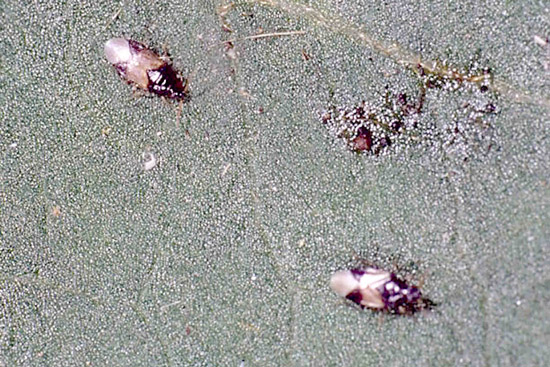Issue 12, July 26, 2013
Minute Pirate Bug
There have been numerous reports of people being bitten by minute pirate bugs throughout the state. A common species, Orius insidiosus, is known as the insidious plant bug.
Adult minute pirate bugs are black and white, flattened, oval bugs about 1/16 inch long. They have a needlelike beak that originates at the front of the head and is bent back under the head when not in use. They use these piercing-sucking mouthparts to penetrate their prey and suck out their juices. They feed primarily on other small insects and mites, being available commercially for the biological control of small plant pests such as spider mites, thrips, and aphids.

Pirate Bug Adults
Minute pirate bugs are native to Illinois and are commonly found on foliage, particularly the blossoms of flowering plants. Adult pirate bugs are excellent fliers; the smaller, brownish nymphs look similar to the adults but have no wings. It is common to have nymphs and adults walking on your arms when hand-weeding, pruning, or otherwise working with outdoor plants. While you’re sitting or walking outdoors, it is common for adult minute pirate bugs to fly onto your arms and other areas of your body.
Many insects determine whether something is good to eat by tasting it. It is thought that minute pirate bugs probe whatever they land on to determine whether it is food. People feel this probe as a pinch-like bite, which is considerably more noticeable than the insect delivering the bite. For many people, the pain is short-lived and nothing comes of the bite. In others, swelling and itching can occur at the bite, probably due to the body’s reaction to foreign proteins that entered the body during the bite.
There is very little that can be done to avoid bites while outside, other than keeping most of your body covered with clothing by wearing long-sleeved shirts and long pants. Minute pirate bugs tend to be more active during the daytime and seem to be particularly active before it rains.
Insect repellents used for protection from mosquitoes, chiggers, and ticks are not effective against these insects. Insect repellents function by confusing the sensory apparatus that insects use to detect us. Mosquitoes and other biting pests are attracted by the lactic acid, carbon dioxide, and other chemicals that we exude from our bodies. Insect repellents keep the insects from detecting these chemicals and following their gradient to us. Thus, insect repellents would perhaps be better called insect non-attractants.
Because minute pirate bugs do not seek humans but randomly land on them, repellents have no effect against them. Some repellents have perfumes added to them to make them more acceptable by people. It is possible that the perfumes in the repellent might even attract the minute pirate bugs because the bugs tend to be numerous on flowers.
Author:
Phil Nixon